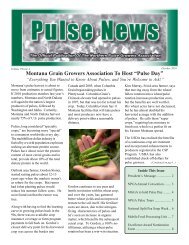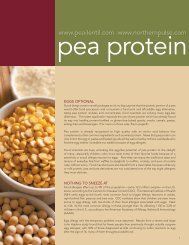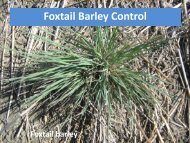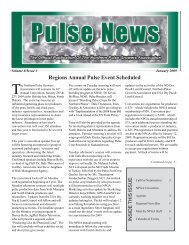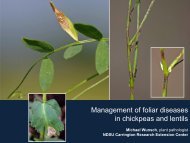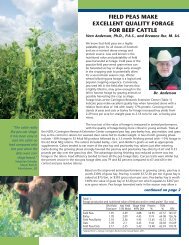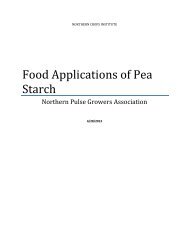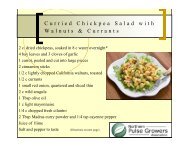Feed Peas in diets for shrimp tilapia and milkfish - Northern Pulse ...
Feed Peas in diets for shrimp tilapia and milkfish - Northern Pulse ...
Feed Peas in diets for shrimp tilapia and milkfish - Northern Pulse ...
You also want an ePaper? Increase the reach of your titles
YUMPU automatically turns print PDFs into web optimized ePapers that Google loves.
SUMMARYThis report summarizes the results of experiments conducted to test the efficacy of feed pea meal (Pisumsativum) as an alternative prote<strong>in</strong> source <strong>in</strong> the <strong>diets</strong> <strong>for</strong> <strong>tilapia</strong>, <strong>milkfish</strong>, <strong>and</strong> <strong>shrimp</strong>. All <strong>for</strong>mulations werebased on the known nutrient requirements (e.g., prote<strong>in</strong>, fat, carbohydrate, prote<strong>in</strong>:energy ratio,<strong>in</strong>dispensable am<strong>in</strong>o acids) of the species specified.Study 1. Shrimp (Penaeus monodon, Fabricius)The potential of feed pea meal as an alternative prote<strong>in</strong> source <strong>in</strong> practical <strong>diets</strong> <strong>for</strong> juvenile tiger <strong>shrimp</strong>was assessed <strong>in</strong> a 12-week feed<strong>in</strong>g trial. Formulated <strong>diets</strong> were made isonitrogenous (40% crude prote<strong>in</strong>)<strong>and</strong> isocaloric (14.5 kJ g –1 ). The control diet conta<strong>in</strong>ed fish meal, soybean meal, squid meal, <strong>shrimp</strong> meal,<strong>shrimp</strong> head meal as prote<strong>in</strong> sources. Prote<strong>in</strong> from feed pea meal replaced 0, 20, 40, 60, 80, <strong>and</strong> 100% ofthe prote<strong>in</strong> from defatted soybean meal <strong>in</strong> the <strong>diets</strong>. These values were equivalent to 0, 5, 10, 15, 20, 25%,respectively, of the total prote<strong>in</strong> <strong>in</strong> the diet. A negative control with no prote<strong>in</strong> sources was added to thetreatment. Twelve <strong>shrimp</strong> post-larvae with an average weight of 0.02±0.01g were r<strong>and</strong>omly assigned <strong>in</strong> 35,60-l oval tanks equipped with a flow-through seawater system. The <strong>shrimp</strong> were fed the <strong>for</strong>mulated <strong>diets</strong> ata daily feed<strong>in</strong>g rate of 20-25% body weight <strong>in</strong> 5 replicate samples.Results showed no significant differences <strong>in</strong> % weight ga<strong>in</strong> (WG)(5162 to 5839); specific growth rate (SGR)(4.4-4.6); feed conversion ratio (FCR) (1.2-1.9); prote<strong>in</strong> efficiency ratio (PER) (1.2-1.7); survival (SURV)(75-100) of <strong>shrimp</strong> fed <strong>diets</strong> with 0 up to the highest level of replacement. Weight ga<strong>in</strong> of <strong>shrimp</strong> fed thenegative control (364) was significantly lower (P>0.05) compared to the rest of the treatments.The apparent dry matter (ADMD) <strong>and</strong> prote<strong>in</strong> (APD) digestibilities of the dry feed pea <strong>in</strong> P. monodon werehigh at 73.38±4.98% <strong>and</strong> 92.74±2.62%, respectively. Digestibility coefficients <strong>for</strong> dry matter (71-77%) <strong>and</strong>prote<strong>in</strong> (83-88%) <strong>for</strong> the feed pea meal-based <strong>diets</strong> <strong>in</strong>creased with <strong>in</strong>creas<strong>in</strong>g level of feed peareplacement.The results <strong>in</strong>dicate that whole feed pea meal can be an alternative prote<strong>in</strong> source <strong>for</strong> <strong>shrimp</strong>. It cansubstitute even up to 100% of the prote<strong>in</strong> from defatted soybean meal, which is equivalent to 25% of thetotal prote<strong>in</strong> <strong>in</strong> the diet. An <strong>in</strong>clusion level of up to 42% <strong>in</strong> the juvenile <strong>shrimp</strong> practical diet did not manifestany adverse effects on growth, feed efficiency, survival, body composition, <strong>and</strong> digestibility coefficients <strong>for</strong>dry matter <strong>and</strong> prote<strong>in</strong> of the <strong>shrimp</strong>.Study 2. Tilapia (Oreochromis niloticus L.)The <strong>tilapia</strong> experiments made use of fish meal-based (experiment 1) <strong>and</strong> plant-based (experiment 2) <strong>diets</strong>to allow maximum level of feed pea as a prote<strong>in</strong> source. In both experiments, all test <strong>diets</strong> were madeisonitrogenous (30% crude prote<strong>in</strong>) <strong>and</strong> isocaloric (14 kJ g –1 ). Water temperature dur<strong>in</strong>g the feed<strong>in</strong>g trialsranged from 22-27°CExperiment 1. Fish meal supplied about 28% prote<strong>in</strong> <strong>in</strong> the <strong>diets</strong>. <strong>Feed</strong> peas (12.7-63.3% of the diet)substituted up to 50% of fish meal prote<strong>in</strong>. Manually sexed male Nile <strong>tilapia</strong>, each weigh<strong>in</strong>g 32-39g atstock<strong>in</strong>g, were used. The fish were reared <strong>in</strong> polyethylene tanks (58x37x27 cm) with aeration undercontrolled conditions. Water was static <strong>and</strong> was partially replaced once a day. Fish were allowed to feed tosatiation twice daily.The various <strong>in</strong>clusion levels of feed peas did not affect body weight, feed<strong>in</strong>g activity, <strong>and</strong> feed efficiency ofthe <strong>tilapia</strong>. Weight ga<strong>in</strong> after 9 weeks (range: 21.7±5.6 to 34.0±9.3g) did not differ significantly amongtreatments (P>0.05). Survival rates were highly variable (40-75%) <strong>and</strong> not significantly different. Mortalitywas not related to treatment. FCR (3.2 to 4.2) <strong>and</strong> PER (0.8 to 1.0) were not significantly different amongtreatments.Experiment 2. <strong>Feed</strong> peas <strong>in</strong> the <strong>diets</strong> ranged from 5.9-41%. <strong>Feed</strong> peas substituted up to 35% of the plantprote<strong>in</strong> (or up to about 30% of total dietary prote<strong>in</strong>). The control diet conta<strong>in</strong>ed fish meal, soybean meal,<strong>and</strong> copra meal as pr<strong>in</strong>cipal prote<strong>in</strong> sources. Separate feed<strong>in</strong>g trials were conducted on two stra<strong>in</strong>s of allmale<strong>tilapia</strong> (CLSU <strong>and</strong> BFAR stra<strong>in</strong>s) under controlled conditions us<strong>in</strong>g the same test <strong>diets</strong> <strong>and</strong> biggertanks (90x78x43 cm).There were no significant differences <strong>in</strong> weight ga<strong>in</strong> among treatments after 12 weeks of feed<strong>in</strong>g (45.5-±7.8to 57.4±12.4g <strong>for</strong> the CLSU stra<strong>in</strong>; 52.5±4.4 to 74.1±9.2g <strong>for</strong> the BFAR stra<strong>in</strong>). Moreover, FCR (3.2 to 4.0)or PER (0.9 to 1.0) were not significantly different among treatments. Survival was 100% <strong>in</strong> all tanks <strong>in</strong>both trials.1




